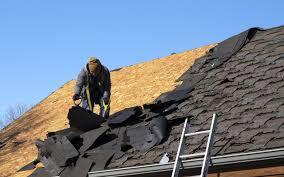
Understanding Roof Tear-Offs: Why Removing Old Roofing Matters
The process of a roof tear-off involves the complete removal of the existing roofing materials down to the roof deck before installing new materials. This critical step is often overlooked or misunderstood, but its significance cannot be overstated when it comes to ensuring the longevity, durability, and functionality of a new roof.
What Does a Roof Tear-Off Involve?
A roof tear-off is a systematic process that involves several steps:
Inspection: Before the tear-off begins, a thorough inspection of the existing roof is conducted to assess its condition, identify any underlying issues, and determine the extent of damage or wear and tear.
Removal of Old Materials: All existing roofing materials, including shingles, underlayment, flashing, and any damaged or deteriorated components, are stripped away. This process exposes the roof deck, allowing for a clear inspection of its condition.
Repairs and Preparation: Once the old materials are removed, any damaged or weakened sections of the roof deck are repaired or replaced as needed. The deck is then prepared to receive the new roofing materials.
Installation of New Roofing: With the roof deck prepared, new underlayment, flashing, and shingles or roofing material are installed according to manufacturer specifications and industry best practices.
Why Remove the Old Roofing?
The decision to remove old roofing rather than overlaying new materials on top is crucial for several reasons:
Identifying Underlying Issues: Removing the old roofing allows for a comprehensive inspection of the roof deck. This step is crucial for uncovering underlying problems such as water damage, rot, or structural issues that may not be visible otherwise. Addressing these issues before installing new roofing prevents potential complications in the future.
Ensuring Proper Installation: Installing new roofing on top of old materials might seem like a time-saving option, but it can compromise the integrity of the roof. It's essential to have a clean, smooth surface to ensure proper adhesion and installation of the new materials. Without a tear-off, the new roof might not lay flat, leading to premature wear and potential leaks.
Enhancing Longevity and Performance: A roof tear-off followed by the installation of new materials ensures a fresh start for your roof. It allows for the proper application of modern, high-quality roofing materials that can better withstand weather elements, thereby extending the roof's lifespan and enhancing its performance.
Compliance and Warranty Considerations: Many roofing material manufacturers and building codes recommend or require a roof tear-off before installing new materials to maintain warranties and comply with regulations. Failure to adhere to these guidelines might void warranties or lead to non-compliance issues.
Conclusion
In essence, a roof tear-off might seem like an additional step or expense, but it is a fundamental part of the roof replacement process. By removing the old roofing, addressing underlying issues, ensuring proper installation, and enhancing the longevity of the new roof, a tear-off becomes an investment in the long-term health and functionality of your home's most crucial protective barrier.
